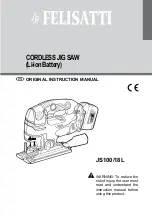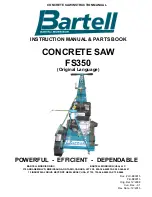
10
Dress for safety.
。
Do not wear loose clothing, gloves, neckties or jewelry
(rings, wrist watches) They can get caught and draw you
into moving parts.
。
Wear no slip footwear-
。
Tie back long hair.
。
Roll long sleeves above the elbow.
。
Noise levels vary widely. To avoid possible hearing
damage, wear earplugs or muffs.
。
For dusty operations, wear a dust mask or respirator
along with safety goggles.
Plan you work to avoid thrown pieces caused
when the workpiece binds on the blade and is
torn from your hands.
Avoid awkward operations and hand positions where a
sudden slip could cause fingers or hand to move into the
blade.
Don't Overreach.
Keep good footing and balance.
Keep your face and body to one side of saw blade, out of
line with possible thrown sparks or dusts.
Never cut
Freehand:
。
Clamp your workpiece solidly against the fence and table
top so it will not rock or twist during the cut.
。
Make sure there's no debris between the workpiece and
its supports-
。
Make sure no gaps between the workpiece, fence and
table will let the workpiece shift after it is cut in two-
。
Keep the cut off piece free to move sideways after it's cut
off. Otherwise, it could get wedged against the blade and
could be thrown violently.
。
Clear everything except the workpiece and related
support .devises off the table before turning the saw on.
。
Secure Work.
Use clamps or a vise to help hold the
work when it's practical.
Use extra caution with large, very small or
awkward workpieces:
。
Use extra supports (tables, saw horses, blocks, etc.) For
any workpieces large enough to tip when not held down
to the tabletop.
。
Never
use another person as a substitute for a table
extension, or as additional support for a workpiece that is
longer or wider than the basic Metal-Cutting saw table or
to help feed, support or pull the workpiece.
。
Do not use this saw to cut pieces too small to let you
easily hold the work with the clamp.
。
When cutting irregularly shaped workpieces, plan your
work so it will not slip and pinch the blade and be torn
from the clamp.
Whenever Saw Is Running:
Warning: Don't allow familiarity (gained from
frequent use of your Metal-Cutting saw) cause a
careless mistake. A careless fraction of a second is
enough to cause a severe injury.
Before starting your cut, watch the Metal-Cutting saw
while it runs. If it makes an unfamiliar noise or vibrates a
lot, stop immediately. Turn the saw off. Unplug the saw. Do
not restart until finding and correcting the problem.
Keep Children Away.
Keep all visitors a safe distance
from the saw. Make sure bystanders are clear of the saw
and workpiece.
Never confine the piece being cut off.
Never
hold it, clamp it, touch it, or use length stops against it
while the blade is spinning. It must be free to move
sideways on its own. If confined, it could get wedged
against the blade and thrown violently.
Let the blade reach full speed before cutting.
Don't Force Tool.
It will do the job better and safer at its
designed rate. Feed the saw into the workspace only fast
enough to let the blade cut without bogging down or
binding.
Before freeing jammed material:
。
Turn saw "OFF" by releasing trigger switch.
。
Wait for all moving parts to stop.
。
Unplug the Metal-Cutting saw.
After finishing a cut:
。
Keep holding the power head down.
,
Release the switch, and wait for all moving parts to stop
before moving your hands.
Before Leaving The Saw:
Never Leave Tool Running Unattended.
Turn
power off Wait for all moving parts to stop.
Make Workshop Childproof.
Lock the shop.
Disconnect master switches. Store tool away from children
and other not qualified to use the tool.


































